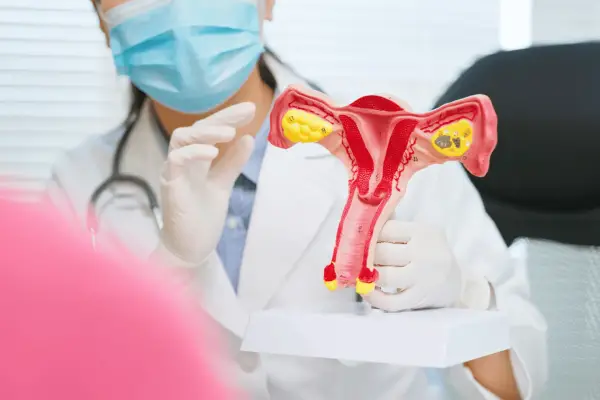![Healthy Matters]() Pharmacist Tips | Dosages | Side effects
Pharmacist Tips | Dosages | Side effects![Healthy Matters]() Nutritionist Tips | Facts | Precautions
Nutritionist Tips | Facts | Precautions![Healthy Matters]() Practitioner Tips | Dosages | Side effects
Practitioner Tips | Dosages | Side effects![Healthy Matters]()
![Healthy Matters]()

Ovarian Cancer: The Silent Intruder
4 min read

Ovarian cancer occurs when there is an abnormal growth of cells in the ovaries. These cells may form a tumour and may destroy healthy body tissue.
There are different types of ovarian cancers, and they determine which treatment may be best for you.
- Epithelial ovarian cancer: This is the most common, and it includes serous carcinoma and mucinous carcinoma
- Stromal tumours: They are rare tumours. Compared with other ovarian cancers, these are diagnosed at an earlier stage
- Germ cell tumours: They are rare, and tend to occur at a younger age
Ovarian cancer: Stages
- Stage 1: This stage is divided into substages A, B, and C.
- Stage 1A: The cancerous cells are present in only one ovary or fallopian tube
- Stage 1B: The cancerous cells are present in both ovaries or fallopian tubes
- Stage 1C: The cancerous cells are present in one or both of the ovaries or fallopian tubes and also:
- There are cancerous cells outside the ovaries or fallopian tubes
- There are cancerous cells in the tissue lining of the peritoneal cavity, the peritoneal cavity, or abdominal fluid
- The capsule of the ovary has broken open
- Stage 2: Cancer has begun to spread. This stage is divided into substages A and B.
- Stage 2A: The cancerous cells have spread from the original site to a secondary site within the reproductive system, such as the ovaries, fallopian tubes, or uterus.
- Stage 2B: The cancerous cells have spread into the peritoneal cavity to the rectum, colon, or bladder
- Stage 3: Advanced ovarian cancer. This stage is divided into substages A, B, and C
- Stage 3A: When the surgeon cannot see the tumour, by pathology reports show that the cancerous cells have spread to the peritoneum or nearby lymph nodes
- Stage 3B: When the surgeon can see the tumour, but it is <2 cm small. Cancer has also spread to the peritoneum or nearby lymph nodes
- Stage 3C: When the surgeon can see the tumour and it is >2 cm large. It has also spread to the peritoneum, liver, spleen, or nearby lymph nodes
- Stage 4: Most advanced ovarian cancer. This stage is divided into substages A and B
- Stage 4A: When the cancerous cells are found in the extra fluid around the lungs
- Stage 4B: When the cancerous cells have spread to other organs, tissues or lymph nodes outside the abdomen.
Ovarian cancer: Causes and risk factors
There is no apparent cause. It is generally when the cells near or in the ovaries have DNA mutations. These mutated cells can invade nearby tissues or other parts of the body by breaking off from the initial tumour.
The risk factors include:
- Old age. Ovarian cancer is mostly diagnosed in post-menopausal women
- Inherited gene changes, e.g. BRACA1 or BRACA2
- A family history of ovarian, breast, endometrial or colon cancer
- Being overweight
Ovarian cancer: Signs and symptoms
Ovarian cancer symptoms may not be noticeable in the beginning. Even when ovarian cancer symptoms begin to present, they are usually attributed to other more common conditions. The signs and symptoms include:
- Abdominal swelling
- Feeling full very quickly when eating
- Changes in bowel habits
- Frequent need for urination
- Weight loss
- Fatigue
- Pelvic discomfort
- Back pain
Ovarian cancer: Treatments
Surgery:
- One ovary removal: For early stage with only one ovary affected, the surgery may involve removing the affected ovary and its fallopian tube. This procedure preserves the ability to have children in the future.
- Both ovary removal: If the cancerous cells are present in both ovaries or fallopian tubes and no signs of additional cancer, then the surgery will sometimes involve removing both ovaries and fallopian tubes. In this case, the uterus will be left intact so you can still become pregnant if you have frozen embryos or eggs, or a donor egg.
- Ovaries and uterus removed: If the cancer is more extensive, then the surgery will include removing both ovaries, both fallopian tubes, the uterus, any nearby lymph nodes, and a part of the omentum.
Chemotherapy:
- These are chemicals that kill the fast-growing cells in the body. This means the cancerous and other healthy body cells are destroyed.
- Chemotherapy can be injected or taken orally.
- Chemotherapy can be used before or after surgery.
Targeted therapy:
- Targeted therapy is when a specific weakness of the cancer cells is identified, and the chemical attacks cells with that specific weakness. This means that fewer healthy body cells are destroyed in the process.
- The doctor may need to test your cancer cells to determine which targeted therapy is more appropriate and effective.
Immunotherapy:
- This involves using your immune system to fight off cancerous cells.
- The cancerous cells may produce certain proteins that allow them to hide from the immune system cells, so immunotherapy interferes with this process.
Hormone therapy:
- This involves using drugs to block the effects of oestrogen on ovarian cancer cells.
- This is because some ovarian cancer cells grow with the use of oestrogen
- This is used in those with slow-growing ovarian cancer, or if cancer comes back after initial treatment
Palliative care:
- The purpose is to provide pain and symptomatic relief.
Ovarian cancer: Prevention
There is no definite prevention for ovarian cancer, however, risk may be reduced through:
- Taking birth control pills. However, these medications also have risks, so it is important to discuss with your healthcare provider the benefits and risk, and your current situation
- Discussing your risk factors with a healthcare provider. If you have a family history of ovarian cancer or breast cancer, you may be referred to do genetic testing.
Ovarian cancer: Complications
- Bowel obstructions: When cancer spreads to the abdomen or pelvis
- Perforated colon: When cancer spreads to the walls of the intestines and perforates them
- Urinary blockage, or urinary retention: When cancer spreads to the pelvis and blocks the ureters
- Malignant pleural effusion: When cancer spreads to the fluid around the lungs
- Bone pain: When cancer spreads to the bones
FAQs
Ovarian cancer is a tumour developing in the ovaries. If left untreated, the cancerous cells can spread to other parts.
Ovarian cancer mainly develops after the age of menopause. It is unusual for women younger than 40 to have ovarian cancer.
Ovarian tumours may break off and theoretically affect the entire body. However, in most cases, it affects the intestines, stomach, and liver.
This article was independently written by Healthy Matters and is not sponsored. It is informative only and not intended to be a substitute for professional medical advice, diagnosis or treatment. It should not be relied upon for specific medical advice.

Your health resource, made in Hong Kong
Healthy Matters is Hong Kong’s leading health resource. Our mission is to help you make better health decisions and take control of your health.
Our team of experts is committed to producing reliable health content that is accurate, engaging and relevant, to cover your health & wellness journey from prevention to treatment.
Whether you are looking for trusted information on health conditions, wellbeing or looking for the right doctor or service in Hong Kong, we’re here to help!
Your health matters. Begin your health journey with Healthy Matters today!
































